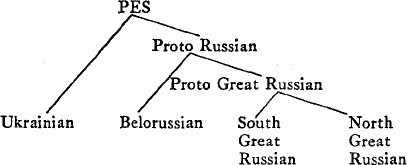No CrossRef data available.
Article contents
A note on language split
Published online by Cambridge University Press: 27 June 2016
Extract
In a historical phonology three kinds of statements must be made: first, there must be a statement of the changes which convert an earlier or proto A into a later or daughter B; second, there must be a statement of the chronology of these changes relative to one another in the time period AB; and third, a statement of whether or not changes in the language area A produce one (B) or more (C, D,…) later systems, and in the latter case, a statement of the relationships between these distinct systems. The first two kinds of statements have been well formulized. This paper will be concerned with the third, a formulation of language split.
- Type
- Research Article
- Information
- Canadian Journal of Linguistics/Revue canadienne de linguistique , Volume 11 , Issue 2 , Spring 1966 , pp. 121 - 126
- Copyright
- Copyright © Canadian Linguistic Association 1966
References
1 Cf. especially Hoenigswald, H., Language Change and Linguistic Reconstruction, Chicago: University of Chicago Press (Toronto: University of Toronto Press), 1960 Google Scholar, chapters 8, 9 and 11.
2 Fairbanks, G. H., Historical Phonology of Russian, Poona: S. M. Katre of Deccan College Post-Graduate and Research Institute, 1965, pp. 2–3 Google Scholar.
3 Ibid., p. 2.
4 Trubetzkoy, N., “Einiges über die russische Lautentwicklung und die Auflösung der gemeinrussischen Spracheinheit,” Zeitschrift für slavische Philologie, 1924, p. 287 Google Scholar.
5
Trubetzkoy also terms this kind of change “wirklich tiefgreifend” and “wesentlich.” Evidently the “wichtige Lautveränderungen” are neither phonemic changes as opposed to phonetic nor more widespread versus less widespread. The purely phonetic change [ç]----[c] is termed “wichtig” as is the phonemic change ![]() (Trubetzkoy, p. 317); and phonemic changes
(Trubetzkoy, p. 317); and phonemic changes ![]() and
and ![]() , characteristic of all East Slavic languages, are “wichtig” as is the geographically restricted
, characteristic of all East Slavic languages, are “wichtig” as is the geographically restricted ![]() (Trubetzkoy, pp. 294 and 317).
(Trubetzkoy, pp. 294 and 317).
6 The juxtaposition of two distinct symbols representing distinct systems from two different horizontal levels denotes the time period between the two. The second member indicates a system derived from the first. Below in the article two symbols from the same horizontal level will be juxtaposed. This will indicate a single language composed of two dialects.
7 Fairbanks, Historical Phonology, p. 1.
8 This type of situation has long been noticed; the Wellentheorie model of linguistic change is one attempt to account for it. Cf. also Paul, Hermann, Prinzipien der Sprachgeschichte, Halle; Verlag Max Niemeyer, 1920 (5th edition), p. 44 Google Scholar; Saussure, Ferdinand de, Course in General Linguistics, trans. by Baskin, Wade, New York: Philosophical Library, 1959, p. 211 Google Scholar; and Bloomfield, Leonard, Language, New York: Holt, 1933, p. 318 Google ScholarPubMed.
9 Fairbanks, , Historical Phonology, p. 81 Google Scholar.
10 Fairbanks splits Proto East Slavic as follows:

Cf. Fairbanks, Historical Phonology, pp. 78 and 42.
11 Such a definition has been implied by Southworth, Franklin, “Family Tree Diagrams,” Lang 40:4, pp. 557–565 CrossRefGoogle Scholar; but to my knowledge it has never been explicitly stated.
12 Rather than proliferate the names for successive stages, numerical subscripts are used. The rectangle indicates the portions of previous stages which have common innovations. Another method of showing this is developed by Southworth.
13 The change differentiating Ukr.1 from Proto Russian1 is phonetically

Using Fairbanks phonemicization of PES, where [e] and [o] are allophones, the change is phonemically

14 This interpretation is taken from my doctoral thesis, A Phonology of Proto East Slavic, Cornell University, 1965.
15 Cf., for example, Hockett, Charles F., A Course in Modern Linguistics, New York: The Macmillan Company (Galt, Brett-Macmillan Ltd.), 1958, pp. 321–329 Google Scholar.
16 Cf. Gleason, H. A. Jr., An Introduction to Descriptive Linguistics, New York: Holt, Rinehart, and Winston, , 1961, pp. 398–401 Google Scholar.


